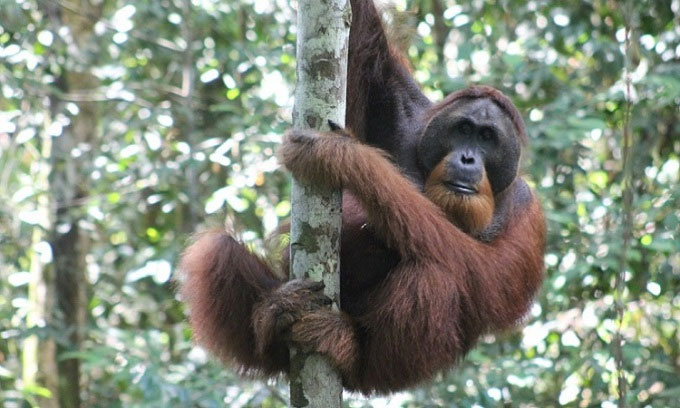Scientists have observed a Bornean orangutan (Pongo pygmaeus) catching, killing, and eating a slow loris, according to a study published on November 17 in the journal Primates.
The research team studied the hunting behavior of orangutans in 2017 at the Tuanan Orangutan Research Station in the Kapuas region of Central Kalimantan, Borneo. They had been monitoring orangutan behavior from 2003 to 2017 and were familiar with their diet. During this research period, the most common foods for orangutans included fruits (61%), young leaves (14%), flowers (8%), and insects (5%). Therefore, the team was quite surprised to witness a male orangutan named Molong attacking another primate.

Bornean orangutans primarily eat plants. (Photo: Borneo Nature Foundation).
Initially, the researchers did not plan to observe Molong. Their focus was on a female orangutan named Kerry and her 3-year-old offspring. The incident began when Molong jumped from the trees and ran on the ground. The research team thought he was fleeing from another male but soon heard a series of calls and quickly discovered he was chasing a Bornean slow loris (Nycticebus borneanus).
This behavior was quite unusual, as slow lorises primarily live in the treetops. Molong continued to pursue the slow loris by moving between branches and running on the ground until he was just a meter away from his target. He used a branch to strike the prey. It is possible that Molong knocked the slow loris down from the tree, a technique often used by Sumatran orangutans to hunt similar prey.
At the end of the hunt, Molong grabbed the slow loris by the leg, bit into its neck, and killed it. After the slow loris was dead, the male orangutan held its body tightly with both hands and began to eat. The sounds attracted the attention of Kerry and her young one, who approached Molong to scavenge the leftovers.
Killing a slow loris is a very risky behavior, even for large orangutans, as they possess potent venom. Slow lorises will rub venom secreted from glands in their elbows onto their teeth before biting an enemy. This venom is strong enough to cause anaphylactic shock in humans. This may explain why Molong continuously moved between tree trunks to pursue his target, carefully handling the slow loris until it was dead and using a branch to transport the body instead of directly using his hands.
Molong’s meal marks one of two instances of orangutans consuming vertebrate animals that scientists have observed during their research. Given the time between the two instances, the research team speculated that Bornean orangutans rarely eat vertebrates, but the number of similar hunting events may be more common and likely overlooked due to the lack of researchers in the area.


















































